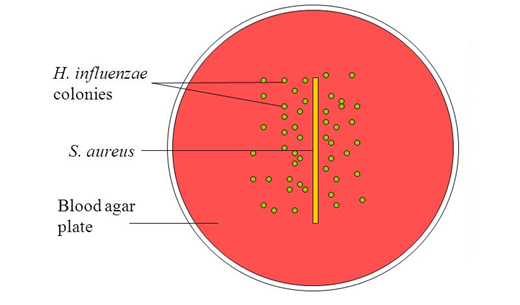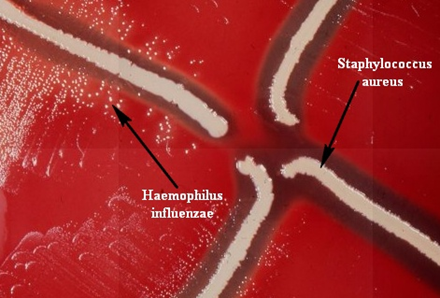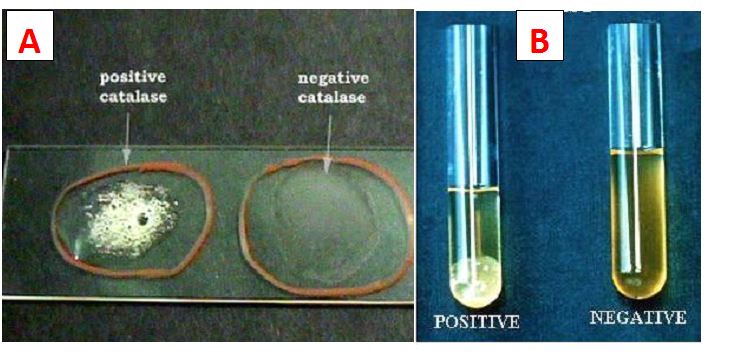Satellitism test is a culture-based test which is used to identify Haemophilus influenzae in the laboratory. Haemophilus influenzae is a fastidious bacterium that requires both X factor (haemin) and V factor (NAD or NADP) for growth. Blood agar lacking any of these growth factors will not support most strains of H. influenzae. When grown in blood culture media, S. aureus produce NAD as a metabolic by product. For that reason, species of Haemophilus may grow very closely to the colonies of S. aureus when streaked on sheep blood agar (Figure 1). S. aureus produces NAD (V factor), a key requirement for the growth of H. influenzae. This phenomenon is known as satelliting, and the test is called satellitism.
AIM: The aim is to confirm and identify H. influenzae strain.

MATERIALS/APPARATUS: Suspect colonies of H. influenzae, sheep blood agar plates, incubator, S. aureus culture, anaerobic jar (for provision of mild CO2 tension), peptone water, tryptic soya agar, swab sticks, inoculating loop.
METHOD/PROCEDURE FOR SATELLITISM TEST
- Mix a loopful of suspected Haemophilus colonies in about 2 ml of sterile peptone water. Ensure that none of the Chocolate agar medium (from which the Haemophilus was obtained from) is transferred into the sterile peptone water tube.
- Aseptically inoculate the suspect Haemophilus colonies on a plate of sheep blood agar and tryptic soya agar.
- Using a sterile loop, streak a pure culture of S. aureus across each of the inoculated sheep blood agar and tryptic soya agar plates.
- Incubate both plates in the incubator at 35-37oC overnight (in the presence of mild CO2 tension).
- Examine the culture plates for growth and satellite colonies of H. influenzae growing towards lawn cultures of S. aureus after culture (Figure 1).
REPORTING OF THE RESULTS:
The suspect colonies are confirmed as H. influenzae if growth of the suspect organism is seen in the sheep blood agar but not in the tryptic soya agar. Secondly, if the colonies of H. influenzae near the column of S. aureus growth are larger than those farthest from it, H. influenzae is also suspected (Figure 2).

Colonies growing farther from the S. aureus column are referred to as “satellite colonies”, which depicts the name of the test satellitism. Colonies of Streptococcus, Neisseria, and Diphtheroids also exhibit the satellitism phenomenon. It is also noteworthy that if satellite colonies are present on both the sheep blood agar and tryptic soya agar plates, then the organism is a Haemophilus species that requires only the V factor (NAD or NADP) for growth.
References
Basic laboratory procedures in clinical bacteriology. World Health Organization (WHO), 1991. Available from WHO publications, 1211 Geneva, 27-Switzerland.
Beers M.H., Porter R.S., Jones T.V., Kaplan J.L and Berkwits M (2006). The Merck Manual of Diagnosis and Therapy. Eighteenth edition. Merck & Co., Inc, USA.
Biosafety in Microbiological and Biomedical Laboratories. 5th edition. U.S Department of Health and Human Services. Public Health Service. Center for Disease Control and Prevention. National Institute of Health. HHS Publication No. (CDC) 21-1112.2009.
Cheesbrough M (2010). District Laboratory Practice in Tropical Countries. Part I. 2nd edition. Cambridge University Press, UK.
Cheesbrough M (2010). District Laboratory Practice in Tropical Countries. Part 2. 2nd edition. Cambridge University Press, UK.
Collins C.H, Lyne P.M, Grange J.M and Falkinham J.O (2004). Collins and Lyne’s Microbiological Methods. Eight edition. Arnold publishers, New York, USA.
Disinfection and Sterilization. (1993). Laboratory Biosafety Manual (2nd ed., pp. 60-70). Geneva: WHO.
Garcia L.S (2010). Clinical Microbiology Procedures Handbook. Third edition. American Society of Microbiology Press, USA.
Garcia L.S (2014). Clinical Laboratory Management. First edition. American Society of Microbiology Press, USA.
Fleming, D. O., Richardson, J. H., Tulis, J. I. and Vesley, D. (eds) (1995). Laboratory Safety: Principles and practice. Washington DC: ASM press.
Dubey, R. C. and Maheshwari, D. K. (2004). Practical Microbiology. S.Chand and Company LTD, New Delhi, India.
Gillespie S.H and Bamford K.B (2012). Medical Microbiology and Infection at a glance. 4th edition. Wiley-Blackwell Publishers, UK.
Discover more from #1 Microbiology Resource Hub
Subscribe to get the latest posts to your email.


